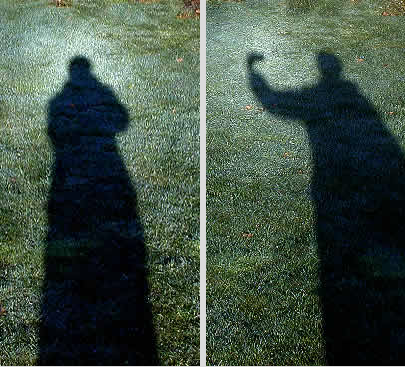Heiligenschein
The Enigmatic Phenomenon of Heiligenschein
When you find yourself on a crisp morning, surrounded by long shadows and dew-covered grass, take a moment to observe the shadow of your head. If you're fortunate, you may notice a captivating sight—a sparkling white glow surrounding the shadow. This intriguing optical phenomenon is known as "heiligenschein," which translates to "holy light" in German.
The heiligenschein appears as a radiant glow that centers around the antisolar point. Similar to the glory and the shadow opposition effect, each observer will have their own heiligenschein since it is specific to their position relative to the light source. Interestingly, as you extend your camera from your eye to arm's length, you will notice that the heiligenschein moves along with it, maintaining its position relative to your viewpoint.
While the glory and the shadow opposition effect create their respective glows through different mechanisms, the heiligenschein generates its distinctive glow in yet another way. The exact process behind the formation of heiligenschein is still not fully understood, adding an air of mystery to this captivating atmospheric phenomenon.
The heiligenschein is not exclusive to human shadows alone; it can also be observed around the shadows of objects such as trees or buildings. The conditions required for heiligenschein to occur involve the presence of small water droplets or ice crystals in the atmosphere. These tiny particles act as miniature mirrors, reflecting sunlight towards the observer and creating the luminous halo effect.
The size and shape of these water droplets or ice crystals play a crucial role in determining the characteristics of the heiligenschein. When the particles are of uniform size, they tend to produce a more pronounced and well-defined glow. Additionally, the presence of a smooth surface on these particles enhances the reflective properties, intensifying the heiligenschein's brilliance.
Although heiligenschein is often associated with dew-covered grass in the early morning, it can also be observed under different atmospheric conditions. For instance, during foggy or misty weather, the suspended water droplets in the air can create a diffuse heiligenschein effect, enveloping objects with a soft and ethereal glow.
In some cases, heiligenschein may exhibit a coloration, ranging from white to pale blue. The coloration arises from the scattering of sunlight by the water droplets or ice crystals in the atmosphere. This scattering phenomenon, known as Rayleigh scattering, causes shorter wavelengths of light (such as blue) to scatter more than longer wavelengths (such as red), resulting in the observed color variations.
The study of heiligenschein has not only captivated the curiosity of scientists but has also fascinated artists and photographers alike. The unique and elusive nature of this atmospheric phenomenon provides inspiration for creative interpretations and artistic representations.
In conclusion, heiligenschein is a mesmerizing optical phenomenon that manifests as a radiant glow surrounding the shadow of an object. While its exact formation process remains somewhat enigmatic, we know that it occurs due to the reflection and scattering of sunlight by small water droplets or ice crystals in the atmosphere. Whether observed on a dewy morning or during foggy weather, heiligenschein adds a touch of magic to our everyday surroundings, reminding us of the beauty and wonder that can be found in the natural world.

On a morning when shadows are long and the grass is dew wetted, look at the shadow of your head. With luck it will be enveloped by a sparkling white glow. This is the 'heiligenschein' or 'holy light'.
The glow is centered on the antisolar point and so, like the glory, each has their own. When I moved the camera from my eye out to arms length, its heiligenschein moved with it.
The Glory and the shadow opposition effect also produce glows around the antisolar point. The heiligenschein's glow is made in yet another way.
Note: this article has been automatically converted from the old site and may not appear as intended. You can find the original article here.
Reference Atmospheric Optics
If you use any of the definitions, information, or data presented on Atmospheric Optics, please copy the link or reference below to properly credit us as the reference source. Thank you!
-
<a href="https://atoptics.co.uk/blog/heiligenschein/">Heiligenschein</a>
-
"Heiligenschein". Atmospheric Optics. Accessed on April 27, 2024. https://atoptics.co.uk/blog/heiligenschein/.
-
"Heiligenschein". Atmospheric Optics, https://atoptics.co.uk/blog/heiligenschein/. Accessed 27 April, 2024
-
Heiligenschein. Atmospheric Optics. Retrieved from https://atoptics.co.uk/blog/heiligenschein/.